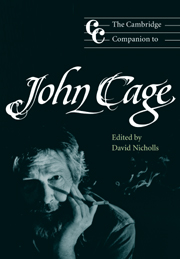5 - Words and writings
from Part II - Sounds, words, images
Published online by Cambridge University Press: 28 September 2011
Summary
Throughout his career, John Cage was an active author, his first musical essays dating from around 1937, and few American composer-authors can rival him in terms of the sheer quantity of musical prose that he generated (Copland and Sessions come to mind as potential peers). Even fewer equal him in formulating an explicit, thoroughly detailed aesthetic, and those who are content with the simplistic image of Cage as the all-permissive composer who espoused a goal to “let sounds be themselves” need to recall that he ultimately wrote several hundred pages' worth of essays and lectures qualifying exactly what he meant by that statement. His first twenty years' worth of writings became available to the general public only in the early 1960s, concurrent with or even before the publication of most of his compositions. Historically, therefore, these prose works were not read by Cage enthusiasts as tangential afterthoughts but served as the initial springboard by which many were first introduced to the composer, sometimes long before the actual opportunity to hear one of his compositions ever arose. In fact, in the context of Cage's total creative output, these writings are not to be regarded as mere peripheral supplements to his music, art or poetry, but as the central means to the comprehension of such works. It would be impossible to accurately summarize the aesthetic parameters of Cage's writings in the brief space of this chapter.
- Type
- Chapter
- Information
- The Cambridge Companion to John Cage , pp. 85 - 99Publisher: Cambridge University PressPrint publication year: 2002
- 4
- Cited by



